3.4E: Exercises
- Page ID
- 30303
Practice Makes Perfect
Find an Equation of the Line Given the Slope and y-Intercept
In the following exercises, find the equation of a line with given slope and y-intercept. Write the equation in slope-intercept form.
1. slope \(3\) and \(y\)-intercept \((0,5)\)
- Answer
-
\(y=3x+5\)
2. slope \(8\) and \(y\)-intercept \((0,−6)\)
3. slope \(−3\) and \(y\)-intercept \((0,−1)\)
- Answer
-
\(y=−3x−1\)
4. slope \(−1\) and \(y\)-intercept \((0,3)\)
5. slope \(\frac{1}{5}\) and \(y\)-intercept \((0,−5)\)
- Answer
-
\(y=\frac{1}{5}x−5\)
6. slope \(−\frac{3}{4}\) and \(y\)-intercept \((0,−2)\)
7. slope \(0\) and \(y\)-intercept \((0,−1)\)
- Answer
-
\(y=−1\)
8. slope \(−4\) and \(y\)-intercept \((0,0)\)
In the following exercises, find the equation of the line shown in each graph. Write the equation in slope-intercept form.
9.
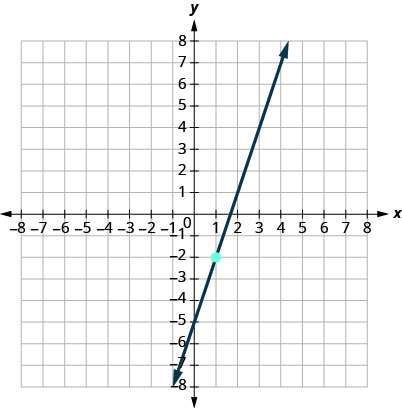
- Answer
-
\(y=3x−5\)
10.
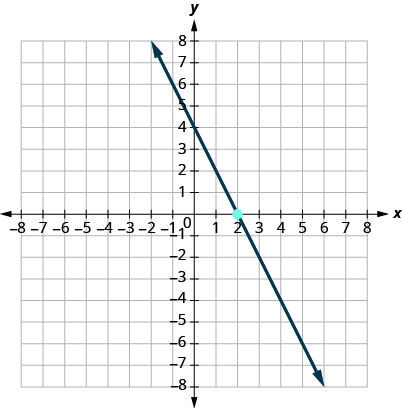
11.
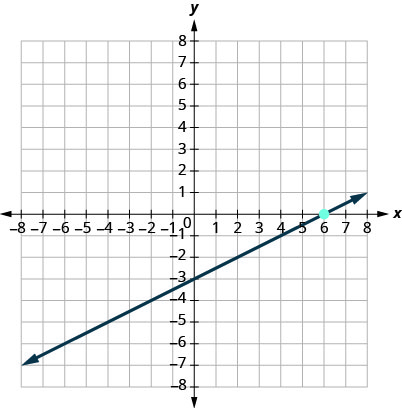
- Answer
-
\(y=\frac{1}{2}x−3\)
12.
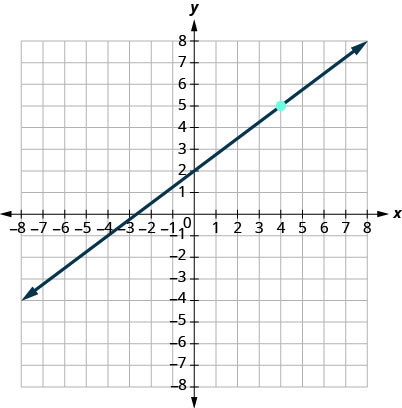
13.
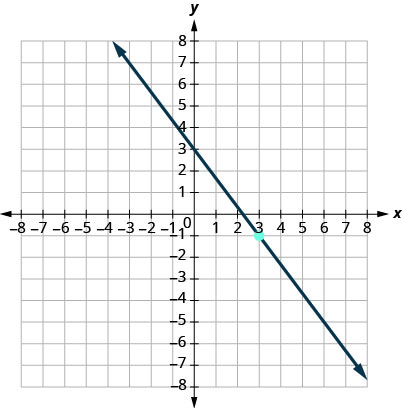
- Answer
-
\(y=−\frac{4}{3}x+3\)
14.
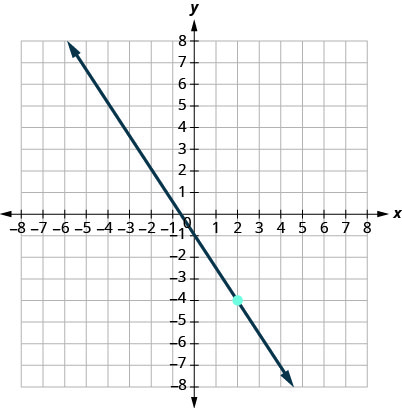
15.
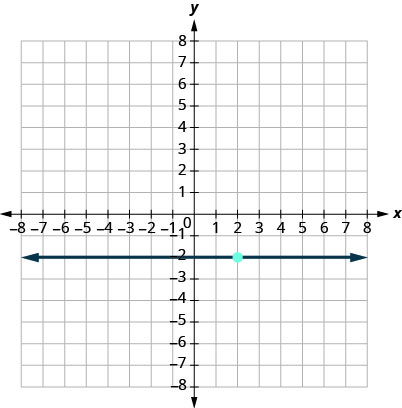
- Answer
-
\(y=−2\)
16.
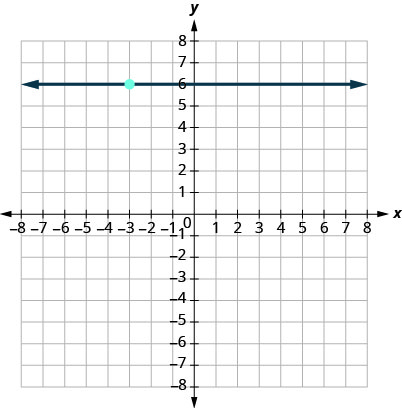
Find an Equation of the Line Given the Slope and a Point
In the following exercises, find the equation of a line with given slope and containing the given point. Write the equation in slope-intercept form.
17. \(m=\frac{5}{8}\), point \((8,3)\)
- Answer
-
\(y=\frac{5}{8}x−2\)
18. \(m=\frac{5}{6}\), point \((6,7)\)
19. \(m=−\frac{3}{5}\), point \((10,−5)\)
- Answer
-
\(y=−\frac{3}{5}x+1\)
20. \(m=−\frac{3}{4}\), point \((8,−5)\)
21. \(m=−\frac{3}{2}\), point \((−4,−3)\)
- Answer
-
\(y=−\frac{3}{2}x+9\)
22. \(m=−\frac{5}{2}\), point \((−8,−2)\)
23. \(m=−7\), point \((−1,−3)\)
- Answer
-
\(y=−7x−10\)
24. \(m=−4\), point \((−2,−3)\)
25. Horizontal line containing \((−2,5)\)
- Answer
-
\(y=5\)
26. Horizontal line containing \((−2,−3)\)
27. Horizontal line containing \((−1,−7)\)
- Answer
-
\(y=−7\)
28. Horizontal line containing \((4,−8)\)
Find an Equation of the Line Given Two Points
In the following exercises, find the equation of a line containing the given points. Write the equation in slope-intercept form.
29. \((2,6)\) and \((5,3)\)
- Answer
-
\(y=−x+8\)
30. \((4,3)\) and \((8,1)\)
31. \((−3,−4)\) and \((5−2)\).
- Answer
-
\(y=\frac{1}{4}x−\frac{13}{4}\)
32. \((−5,−3)\) and \((4,−6)\).
33. \((−1,3)\) and \((−6,−7)\).
- Answer
-
\(y=2x+5\)
34. \((−2,8)\) and \((−4,−6)\).
35. \((0,4)\) and \((2,−3)\).
- Answer
-
\(y=−\frac{7}{2}x+4\)
36. \((0,−2)\) and \((−5,−3)\).
37. \((7,2)\) and \((7,−2)\).
- Answer
-
\(x=7\)
38. \((−2,1)\) and \((−2,−4)\).
39. \((3,−4)\) and \((5,−4)\).
- Answer
-
\(y=−4\)
40. \((−6,−3)\) and \((−1,−3)\)
Find an Equation of a Line Parallel to a Given Line
In the following exercises, find an equation of a line parallel to the given line and contains the given point. Write the equation in slope-intercept form.
41. line \(y=4x+2\), point \((1,2)\)
- Answer
-
\(y=4x−2\)
42. line \(y=−3x−1\), point \(2,−3)\).
43. line \(2x−y=6\), point \((3,0)\).
- Answer
-
\(y=2x−6\)
44. line \(2x+3y=6\), point \((0,5)\).
45. line \(x=−4\), point \((−3,−5)\).
- Answer
-
\(x=−3\)
46. line \(x−2=0\), point \((1,−2)\)
47. line \(y=5\), point \((2,−2)\)
- Answer
-
\(y=−2\)
48. line \(y+2=0\), point \((3,−3)\)
Find an Equation of a Line Perpendicular to a Given Line
In the following exercises, find an equation of a line perpendicular to the given line and contains the given point. Write the equation in slope-intercept form.
49. line \(y=−2x+3\), point \((2,2)\)
- Answer
-
\(y=\frac{1}{2}x+1\)
50. line \(y=−x+5\), point \((3,3)\)
51. line \(y=\frac{3}{4}x−2\), point \((−3,4)\)
- Answer
-
\(y=−\frac{4}{3}x\)
52. line \(y=\frac{2}{3}x−4\), point \((2,−4)\)
53. line \(2x−3y=8\), point \((4,−1)\)
- Answer
-
\(y=−\frac{3}{2}x+5\)
54. line \(4x−3y=5\), point \((−3,2)\)
55. line \(2x+5y=6\), point \((0,0)\)
- Answer
-
\(y=\frac{5}{2}x\)
56. line \(4x+5y=−3\), point \((0,0)\)
57. line \(x=3\), point \((3,4)\)
- Answer
-
\(y=4\)
58. line \(x=−5\), point \((1,−2)\)
59. line \(x=7\), point \((−3,−4)\)
- Answer
-
\(y=−4\)
60. line \(x=−1\), point \((−4,0)\)
61. line \(y−3=0\), point \((−2,−4)\)
- Answer
-
\(x=−2\)
62. line \(y−6=0\), point \((−5,−3)\)
63. line \(y\)-axis, point \((3,4)\)
- Answer
-
\(y=4\)
64. line \(y\)-axis, point \((2,1)\)
Mixed Practice
In the following exercises, find the equation of each line. Write the equation in slope-intercept form.
65. Containing the points \((4,3)\) and \((8,1)\)
- Answer
-
\(y=−\frac{1}{2}x+5\)
66. Containing the points \((−2,0)\) and \((−3,−2)\)
67. \(m=\frac{1}{6}\), containing point \((6,1)\)
- Answer
-
\(y=\frac{1}{6}x\)
68. \(m=\frac{5}{6}\), containing point \((6,7)\)
69. Parallel to the line \(4x+3y=6\), containing point \((0,−3)\)
- Answer
-
\(y=−\frac{4}{3}x−3\)
70. Parallel to the line \(2x+3y=6\), containing point \((0,5)\)
71. \(m=−\frac{3}{4}\), containing point \((8,−5)\)
- Answer
-
\(y=−\frac{3}{4}x+1\)
72. \(m=−\frac{3}{5}\), containing point \((10,−5)\)
73. Perpendicular to the line \(y−1=0\), point \((−2,6)\)
- Answer
-
\(x=−2\)
74. Perpendicular to the line y-axis, point \((−6,2)\)
75. Parallel to the line \(x=−3\), containing point \((−2,−1)\)
- Answer
-
\(x=−2\)
76. Parallel to the line \(x=−4\), containing point \((−3,−5)\)
77. Containing the points \((−3,−4)\) and \((2,−5)\)
- Answer
-
\(y=−\frac{1}{5}x−\frac{23}{5}\)
78. Containing the points \((−5,−3)\) and \((4,−6)\)
79. Perpendicular to the line \(x−2y=5\), point \((−2,2)\)
- Answer
-
\(y=−2x−2\)
80. Perpendicular to the line \(4x+3y=1\), point \((0,0)\)
Writing Exercises
81. Why are all horizontal lines parallel?
- Answer
-
Answers will vary.
82. Explain in your own words why the slopes of two perpendicular lines must have opposite signs.
Self Check
a. After completing the exercises, use this checklist to evaluate your mastery of the objectives of this section.
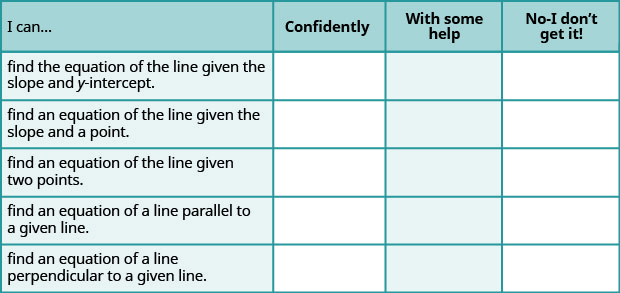
b. What does this checklist tell you about your mastery of this section? What steps will you take to improve?


